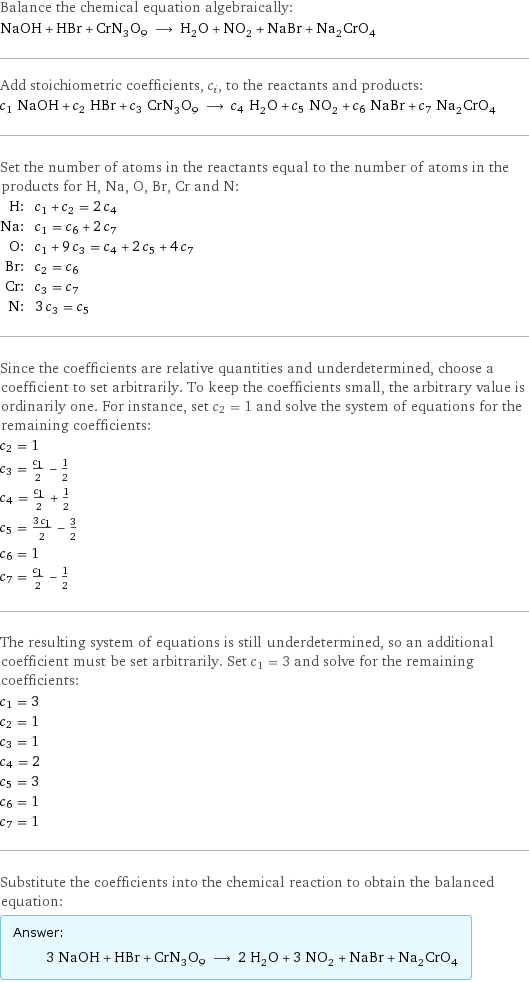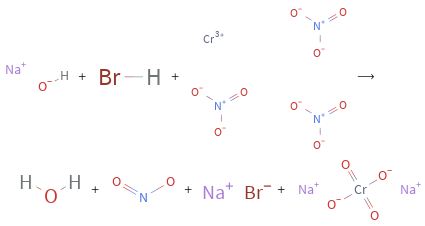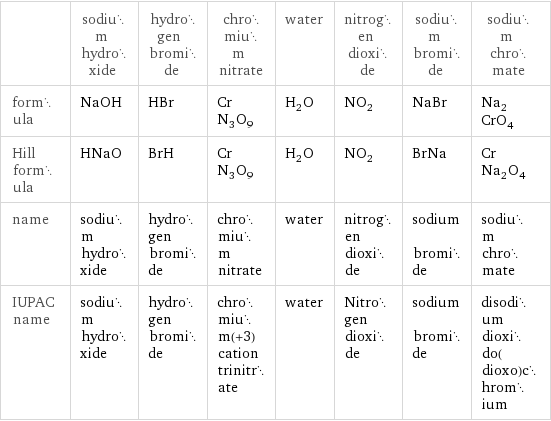Input interpretation

NaOH sodium hydroxide + HBr hydrogen bromide + CrN_3O_9 chromium nitrate ⟶ H_2O water + NO_2 nitrogen dioxide + NaBr sodium bromide + Na_2CrO_4 sodium chromate
Balanced equation

Balance the chemical equation algebraically: NaOH + HBr + CrN_3O_9 ⟶ H_2O + NO_2 + NaBr + Na_2CrO_4 Add stoichiometric coefficients, c_i, to the reactants and products: c_1 NaOH + c_2 HBr + c_3 CrN_3O_9 ⟶ c_4 H_2O + c_5 NO_2 + c_6 NaBr + c_7 Na_2CrO_4 Set the number of atoms in the reactants equal to the number of atoms in the products for H, Na, O, Br, Cr and N: H: | c_1 + c_2 = 2 c_4 Na: | c_1 = c_6 + 2 c_7 O: | c_1 + 9 c_3 = c_4 + 2 c_5 + 4 c_7 Br: | c_2 = c_6 Cr: | c_3 = c_7 N: | 3 c_3 = c_5 Since the coefficients are relative quantities and underdetermined, choose a coefficient to set arbitrarily. To keep the coefficients small, the arbitrary value is ordinarily one. For instance, set c_2 = 1 and solve the system of equations for the remaining coefficients: c_2 = 1 c_3 = c_1/2 - 1/2 c_4 = c_1/2 + 1/2 c_5 = (3 c_1)/2 - 3/2 c_6 = 1 c_7 = c_1/2 - 1/2 The resulting system of equations is still underdetermined, so an additional coefficient must be set arbitrarily. Set c_1 = 3 and solve for the remaining coefficients: c_1 = 3 c_2 = 1 c_3 = 1 c_4 = 2 c_5 = 3 c_6 = 1 c_7 = 1 Substitute the coefficients into the chemical reaction to obtain the balanced equation: Answer: | | 3 NaOH + HBr + CrN_3O_9 ⟶ 2 H_2O + 3 NO_2 + NaBr + Na_2CrO_4
Structures

+ + ⟶ + + +
Names

sodium hydroxide + hydrogen bromide + chromium nitrate ⟶ water + nitrogen dioxide + sodium bromide + sodium chromate
Equilibrium constant
![Construct the equilibrium constant, K, expression for: NaOH + HBr + CrN_3O_9 ⟶ H_2O + NO_2 + NaBr + Na_2CrO_4 Plan: • Balance the chemical equation. • Determine the stoichiometric numbers. • Assemble the activity expression for each chemical species. • Use the activity expressions to build the equilibrium constant expression. Write the balanced chemical equation: 3 NaOH + HBr + CrN_3O_9 ⟶ 2 H_2O + 3 NO_2 + NaBr + Na_2CrO_4 Assign stoichiometric numbers, ν_i, using the stoichiometric coefficients, c_i, from the balanced chemical equation in the following manner: ν_i = -c_i for reactants and ν_i = c_i for products: chemical species | c_i | ν_i NaOH | 3 | -3 HBr | 1 | -1 CrN_3O_9 | 1 | -1 H_2O | 2 | 2 NO_2 | 3 | 3 NaBr | 1 | 1 Na_2CrO_4 | 1 | 1 Assemble the activity expressions accounting for the state of matter and ν_i: chemical species | c_i | ν_i | activity expression NaOH | 3 | -3 | ([NaOH])^(-3) HBr | 1 | -1 | ([HBr])^(-1) CrN_3O_9 | 1 | -1 | ([CrN3O9])^(-1) H_2O | 2 | 2 | ([H2O])^2 NO_2 | 3 | 3 | ([NO2])^3 NaBr | 1 | 1 | [NaBr] Na_2CrO_4 | 1 | 1 | [Na2CrO4] The equilibrium constant symbol in the concentration basis is: K_c Mulitply the activity expressions to arrive at the K_c expression: Answer: | | K_c = ([NaOH])^(-3) ([HBr])^(-1) ([CrN3O9])^(-1) ([H2O])^2 ([NO2])^3 [NaBr] [Na2CrO4] = (([H2O])^2 ([NO2])^3 [NaBr] [Na2CrO4])/(([NaOH])^3 [HBr] [CrN3O9])](../image_source/4badea40dfc0ce691b30951494133944.png)
Construct the equilibrium constant, K, expression for: NaOH + HBr + CrN_3O_9 ⟶ H_2O + NO_2 + NaBr + Na_2CrO_4 Plan: • Balance the chemical equation. • Determine the stoichiometric numbers. • Assemble the activity expression for each chemical species. • Use the activity expressions to build the equilibrium constant expression. Write the balanced chemical equation: 3 NaOH + HBr + CrN_3O_9 ⟶ 2 H_2O + 3 NO_2 + NaBr + Na_2CrO_4 Assign stoichiometric numbers, ν_i, using the stoichiometric coefficients, c_i, from the balanced chemical equation in the following manner: ν_i = -c_i for reactants and ν_i = c_i for products: chemical species | c_i | ν_i NaOH | 3 | -3 HBr | 1 | -1 CrN_3O_9 | 1 | -1 H_2O | 2 | 2 NO_2 | 3 | 3 NaBr | 1 | 1 Na_2CrO_4 | 1 | 1 Assemble the activity expressions accounting for the state of matter and ν_i: chemical species | c_i | ν_i | activity expression NaOH | 3 | -3 | ([NaOH])^(-3) HBr | 1 | -1 | ([HBr])^(-1) CrN_3O_9 | 1 | -1 | ([CrN3O9])^(-1) H_2O | 2 | 2 | ([H2O])^2 NO_2 | 3 | 3 | ([NO2])^3 NaBr | 1 | 1 | [NaBr] Na_2CrO_4 | 1 | 1 | [Na2CrO4] The equilibrium constant symbol in the concentration basis is: K_c Mulitply the activity expressions to arrive at the K_c expression: Answer: | | K_c = ([NaOH])^(-3) ([HBr])^(-1) ([CrN3O9])^(-1) ([H2O])^2 ([NO2])^3 [NaBr] [Na2CrO4] = (([H2O])^2 ([NO2])^3 [NaBr] [Na2CrO4])/(([NaOH])^3 [HBr] [CrN3O9])
Rate of reaction
![Construct the rate of reaction expression for: NaOH + HBr + CrN_3O_9 ⟶ H_2O + NO_2 + NaBr + Na_2CrO_4 Plan: • Balance the chemical equation. • Determine the stoichiometric numbers. • Assemble the rate term for each chemical species. • Write the rate of reaction expression. Write the balanced chemical equation: 3 NaOH + HBr + CrN_3O_9 ⟶ 2 H_2O + 3 NO_2 + NaBr + Na_2CrO_4 Assign stoichiometric numbers, ν_i, using the stoichiometric coefficients, c_i, from the balanced chemical equation in the following manner: ν_i = -c_i for reactants and ν_i = c_i for products: chemical species | c_i | ν_i NaOH | 3 | -3 HBr | 1 | -1 CrN_3O_9 | 1 | -1 H_2O | 2 | 2 NO_2 | 3 | 3 NaBr | 1 | 1 Na_2CrO_4 | 1 | 1 The rate term for each chemical species, B_i, is 1/ν_i(Δ[B_i])/(Δt) where [B_i] is the amount concentration and t is time: chemical species | c_i | ν_i | rate term NaOH | 3 | -3 | -1/3 (Δ[NaOH])/(Δt) HBr | 1 | -1 | -(Δ[HBr])/(Δt) CrN_3O_9 | 1 | -1 | -(Δ[CrN3O9])/(Δt) H_2O | 2 | 2 | 1/2 (Δ[H2O])/(Δt) NO_2 | 3 | 3 | 1/3 (Δ[NO2])/(Δt) NaBr | 1 | 1 | (Δ[NaBr])/(Δt) Na_2CrO_4 | 1 | 1 | (Δ[Na2CrO4])/(Δt) (for infinitesimal rate of change, replace Δ with d) Set the rate terms equal to each other to arrive at the rate expression: Answer: | | rate = -1/3 (Δ[NaOH])/(Δt) = -(Δ[HBr])/(Δt) = -(Δ[CrN3O9])/(Δt) = 1/2 (Δ[H2O])/(Δt) = 1/3 (Δ[NO2])/(Δt) = (Δ[NaBr])/(Δt) = (Δ[Na2CrO4])/(Δt) (assuming constant volume and no accumulation of intermediates or side products)](../image_source/353cc8ba959ba557e72617a178afa047.png)
Construct the rate of reaction expression for: NaOH + HBr + CrN_3O_9 ⟶ H_2O + NO_2 + NaBr + Na_2CrO_4 Plan: • Balance the chemical equation. • Determine the stoichiometric numbers. • Assemble the rate term for each chemical species. • Write the rate of reaction expression. Write the balanced chemical equation: 3 NaOH + HBr + CrN_3O_9 ⟶ 2 H_2O + 3 NO_2 + NaBr + Na_2CrO_4 Assign stoichiometric numbers, ν_i, using the stoichiometric coefficients, c_i, from the balanced chemical equation in the following manner: ν_i = -c_i for reactants and ν_i = c_i for products: chemical species | c_i | ν_i NaOH | 3 | -3 HBr | 1 | -1 CrN_3O_9 | 1 | -1 H_2O | 2 | 2 NO_2 | 3 | 3 NaBr | 1 | 1 Na_2CrO_4 | 1 | 1 The rate term for each chemical species, B_i, is 1/ν_i(Δ[B_i])/(Δt) where [B_i] is the amount concentration and t is time: chemical species | c_i | ν_i | rate term NaOH | 3 | -3 | -1/3 (Δ[NaOH])/(Δt) HBr | 1 | -1 | -(Δ[HBr])/(Δt) CrN_3O_9 | 1 | -1 | -(Δ[CrN3O9])/(Δt) H_2O | 2 | 2 | 1/2 (Δ[H2O])/(Δt) NO_2 | 3 | 3 | 1/3 (Δ[NO2])/(Δt) NaBr | 1 | 1 | (Δ[NaBr])/(Δt) Na_2CrO_4 | 1 | 1 | (Δ[Na2CrO4])/(Δt) (for infinitesimal rate of change, replace Δ with d) Set the rate terms equal to each other to arrive at the rate expression: Answer: | | rate = -1/3 (Δ[NaOH])/(Δt) = -(Δ[HBr])/(Δt) = -(Δ[CrN3O9])/(Δt) = 1/2 (Δ[H2O])/(Δt) = 1/3 (Δ[NO2])/(Δt) = (Δ[NaBr])/(Δt) = (Δ[Na2CrO4])/(Δt) (assuming constant volume and no accumulation of intermediates or side products)
Chemical names and formulas

| sodium hydroxide | hydrogen bromide | chromium nitrate | water | nitrogen dioxide | sodium bromide | sodium chromate formula | NaOH | HBr | CrN_3O_9 | H_2O | NO_2 | NaBr | Na_2CrO_4 Hill formula | HNaO | BrH | CrN_3O_9 | H_2O | NO_2 | BrNa | CrNa_2O_4 name | sodium hydroxide | hydrogen bromide | chromium nitrate | water | nitrogen dioxide | sodium bromide | sodium chromate IUPAC name | sodium hydroxide | hydrogen bromide | chromium(+3) cation trinitrate | water | Nitrogen dioxide | sodium bromide | disodium dioxido(dioxo)chromium